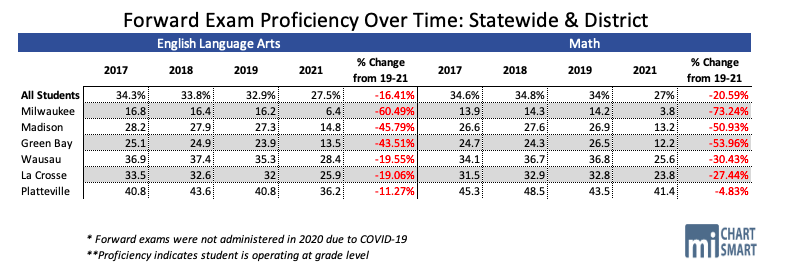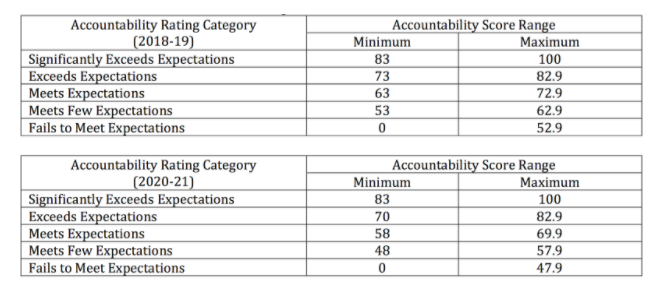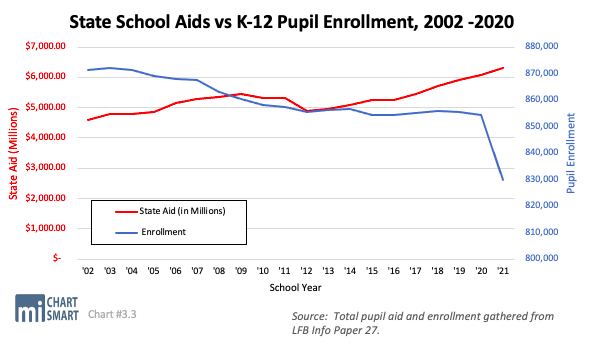
If the majority of our children are not at grade level, how can nearly all of our school districts be graded as meeting or exceeding expectations?
November 18, 2021
In its most recent K12 academic achievement data release, the Department of Public Instruction has published the School Report Cards for individual schools and school districts in Wisconsin. According to DPI, the report cards are part of the state accountability system and track “four priority areas: achievement; growth; target group outcomes; and on-track to graduation.”
Each year, Wisconsin students take a series of standardized tests to assess their proficiency in a range of different subjects. These test results and other metrics are a useful tool to track a student’s academic progress and also gauge the overall effectiveness of Wisconsin’s K12 education system. Report cards for schools and school districts, when coupled with the test scores for students, should give parents a good idea if a school district, and a specific school within that district, are meeting the academic needs of their children. Notice we said should.

According to DPI’s accountability system, schools and districts are scored on a 0-100, five-star scale, from “Fails to Meet Expectations” to “Significantly Exceeds Expectations.” If a district or school does not have enough students to assess, other alternative accountability measures are applied.
We must point out the unusually easy the grading scale is that DPI uses in their District Report Cards. A school or district that “Significantly Exceeds Expectations,” receiving a five-star score, needs only receive 83 on the accountability score. While grading scales differ by district, for students, an 83 tends to be a B or B-. This level of performance “Significantly Exceeds Expectations”?!
On the flip side, in order for a district to fail to meet expectations, they have to score below 47.9 on DPI’s scale. A district that meets expectations would score between a 58 and 69.9 — traditionally an F in the classroom. How is that meeting expectations?
It should be noted that without any public notice or comment, DPI changed the grading scale this year and made the curve easier for a school to receive a passing grade. In the last report card, in order for a school district or school to qualify as having “Exceeds Expectations”, a minimum score of 73 was required. (I’m not sure if taxpayers would consider a 73 as exceeding expectations but that was the minimum score set by DPI in 2019.) Now, the minimum score to reach exceeding expectations is 70, a full three points lower. The minimum score to reach the supposed satisfactory level, in traditional grading terms the “C” level, was reduced from 63 to 58.

Making the already generous grading curve even more generous, some might say easy, partially explains how DPI, in their press release, can assert that 95% of districts “met, exceeded, or significantly exceeded expectations.” The average report card score for a Wisconsin school district in 2021 was 71.6 or exceeding expectations. Of Wisconsin’s 421 school districts, in 2021, 39 districts significantly exceed expectations, 210 districts exceed expectations, 150 meet expectations, 19 districts meet few expectations, and 2 districts fail to meet expectations (one district did not report a score).

Representative Jeremy Thiesfeldt, Chairman of the Assembly Committee on Education, called out State Superintendent of Public Instruction Jill Underly for misleading the public. “Superintendent Underly is creating a mirage with the data. This action seeks to hide from parents the impact of the poor decisions made in schools across Wisconsin during 2020. Students are best served when parents are told the truth.”
Not only is the scale easy to begin with — DPI made a concerted effort to make the scale even easier.
The state’s largest districts received a range of scores on their report cards. Milwaukee Public Schools received 58.1, Madison Metropolitan received 70.2, Green Bay Area Schools received 59.5, Wausau Schools received 68, La Crosse received 63.6, and Platteville received 71.2. Compare this data with the schools’ proficiency scores below.

Beloit School District and Lake Holcombe District both received only one star, failing to meet expectations. This is up from 2019, where only one District — the Mercer School District — failed to meet expectations. Mercer now “meets few expectations.”
The state’s best school districts are Swallow, North Lake, and Lake Country, scoring 96.9, 95.9, and 93.5, respectively.
At the school level, 2,101 of the state’s public schools and 376 choice schools received report cards, with 1,781 — roughly 85% of schools — meeting, exceeding, or significantly exceeding expectations. The average score for a Wisconsin school is 70.9, barely exceeding expectations. It must be noted that 199 schools received “Alternate Ratings” and 279 had an overall rating as “NA”.
How can 95% of districts be “meeting, exceeding, or significantly exceeding expectations,” while less than a third of Wisconsin students are proficient — not operating at grade level — in ELA or math?
The state’s lowest-scoring schools, North Division High and Grandview High — both in MPS — scored 12.6 and 12.8 respectively. On the flip side, the state’s highest-scoring schools in 2021 were Odyssey-Magellan of the Appleton Area School District, scoring 99.5, and Woodland Intermediate of the Kimberly Area District, scoring 98.8.
A cynic would ask how can 95% of districts be “meeting, exceeding, or significantly exceeding expectations,” while less than a third of Wisconsin students are proficient — not operating at grade level — in ELA or math? While there are other metrics that factor into the school report cards, it is still appalling that proficiency levels are so low, while districts are rated so high.
Even using fuzzy math, the numbers do not add up. Every measure of academic achievement for our kids has gotten worse recently, some like proficiency have gotten much worse, and yet, somehow, so many of our school districts grade well and over 70% of our individual schools grade well. How can that be?

Over the past year, Wisconsin schools have received historic levels of funding through the federal COVID aid and the state budget. Yet, in spite of this, we still are seeing dismal results for our children. Chairwoman of the Senate Committee on Education, Senator Darling (R – River Hills), correctly said regarding the report cards, “Wisconsin schools are receiving historic levels of funding. What they need now is real leadership and not roadblocks to reform from the Governor.”
The MacIver Institute will continue to analyze the report card data and update our findings, so be sure to follow our website and social media for the latest.